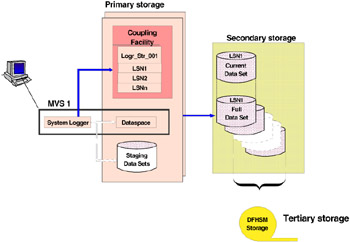2.1 Common System Logger terms
|
| < Day Day Up > |
|
2.1 Common System Logger terms
There are a number of terms used when discussing System Logger that are common across all the exploiters. In order to understand the subsequent discussions in this book, it is important to be familiar with these terms. Figure 2-1 shows how log data managed by System Logger spans multiple storage mediums. This is a useful picture as it helps to introduce several of the terms we will be discussing.

Figure 2-1: System Logger spanning different levels of storage
Figure 2-1 gives you a picture of a system logger configuration. Following are terms that are used to describe system logger elements and processes:
System Logger
A component of the operating system that provides logging services. This component is commonly referred to as the MVS System Logger, OS/390 System Logger, z/OS System Logger, or simply as System Logger or just Logger. While there are enhancements that have been introduced by specific releases of the operating system, these terms are generally used interchangeably, irrespective of the release or version of the operating system being used.
Log streams
A sequence of data blocks, with each log stream identified by its own log stream identifier—the log stream name (LSN). Log streams data can span multiple recording media: interim (primary) storage, secondary (DASD based) storage, and tertiary (that is, tape migrated) media.
Interim Storage
Interim storage is the primary storage used to hold log data that has not yet been offloaded.The interim storage medium used depends on how the log stream has been defined; it may be a Coupling Facility (CF) structure or a staging data set. Log data that is in interim storage is duplexed to prevent against data loss conditions. The data is usually duplexed to a dataspace, although log streams residing in a CF structure may optionally be duplexed to a staging data set.
LOGR Couple Data Set
The LOGR Couple Data Set (CDS) holds the System Logger policy information and information about all defined log streams, and must be accessible by all the systems in the sysplex.
Defining the LOGR CDS and the System Logger policy information is one of the first tasks you must complete when preparing to migrate to a System Logger environment. See z/OS MVS Setting Up a Sysplex, SA22-7625 for information about the LOGR CDS.
CF structure definitions
All the CF structures used by the System Logger must be defined in advance in the CFRM policy. See z/OS MVS Setting Up a Sysplex, SA22-7625, for information about defining the CFRM policy.
Log stream definitions
The log streams are defined using the IXCMIAPU program, and the definitions are stored in the System Logger policy in the LOGR CDS.
Offload
The process of moving valid (not yet deleted) data from interim storage to offload data sets. An offload is generally triggered when the high offload threshold specified for the log stream is reached; however there are other events that will cause an offload to occur. See 2.6, "Offload processing" on page 57 for more information.
Offload data sets
Auxiliary storage on DASD for log streams, sometimes also referred to as log data sets or log stream data sets; they are single extent VSAM linear data sets. When the interim storage for a log stream is filled to its high offload threshold point, the System Logger begins offloading data from interim storage to the offload data sets.
The naming convention for offload data sets is:
<EHLQ or HLQ>.<streamname>.<seq#>
Staging data sets
Interim storage on DASD used to duplex log data that has not yet been offloaded to offload data sets. Staging data sets are required for DASD-only log streams, and are optional for CF-Structure based log streams.
The naming convention for staging data sets differs based on the type of log stream.
For CF-Structure based log streams, the naming convention is:
<EHLQ or HLQ>.<streamname>.<system name>
For DASD-only log streams, the naming convention is:
<EHLQ or HLQ>.<streamname>.<sysplex name>
Log record
A log record is a single record as produced by the exploiter. It could be something like a line from syslog, for example. Or it could be a before-image created by a data manager before it updates a record in a database.
Log block
Exploiters have a choice when sending data to System Logger. The log data can be sent every time a new log record is created, or log records can be written to a buffer and subsequently sent to System Logger. In either case, the piece of data that is sent to System Logger is called a log block. It is transparent to System Logger whether the log block contains a single log record or many log records.
|
| < Day Day Up > |
|